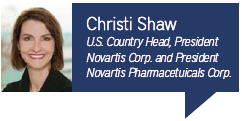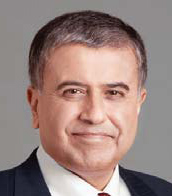What 9 Of Biopharma's Biggest Trendsetters Expect For 2016
By Rob Wright, Chief Editor, Life Science Leader
Follow Me On Twitter @RfwrightLSL
 Modern forecasters use a variety of means to deduce what may lie ahead. And while futurists utilize creativity, carefully structured surveys, computer simulations, and role-playing games in an effort to foretell the next big thing, one of their best predictive means remains the systematic scanning of news media and published scientific studies. The reason is simple. If you want to decipher the difference between an impossible-to-predict fad (e.g., the 2014 ALS Ice Bucket Challenge) and the underlying trend that drove the phenomenon (e.g., the ever-growing power of social media to influence and unify millions), it still pays to observe the actions of industry execs. Biopharma executives, responsible for allocating millions and billions of dollars that drive company strategy, are the life science trendsetters. To that end, Life Science Leader magazine asked nine executive-level decision makers to share their insider insights on what will be big for biopharma in 2016.
Modern forecasters use a variety of means to deduce what may lie ahead. And while futurists utilize creativity, carefully structured surveys, computer simulations, and role-playing games in an effort to foretell the next big thing, one of their best predictive means remains the systematic scanning of news media and published scientific studies. The reason is simple. If you want to decipher the difference between an impossible-to-predict fad (e.g., the 2014 ALS Ice Bucket Challenge) and the underlying trend that drove the phenomenon (e.g., the ever-growing power of social media to influence and unify millions), it still pays to observe the actions of industry execs. Biopharma executives, responsible for allocating millions and billions of dollars that drive company strategy, are the life science trendsetters. To that end, Life Science Leader magazine asked nine executive-level decision makers to share their insider insights on what will be big for biopharma in 2016.
What Global Macro Trends Will Have Significant Bearing On Biopharma?
 "We are in an unprecedented era where we are facing increased pressure to demonstrate the value of true innovation. Patients, doctors, regulatory agencies, and payers are scrutinizing much more carefully the value medicines offer. If a society wants to participate in and benefit from new therapeutic options and improved medical treatment, the economic success of R&D-intensive pharmaceutical companies is mandatory. That innovation will need to be rewarded to secure our business model — based on costly R&D. We as the biopharma industry have to clearly communicate, educate, and engage with stakeholders to demonstrate the difference between companies that bring novel drugs to market serving medical unmet needs and those companies that barely invest a dollar in innovation."
"We are in an unprecedented era where we are facing increased pressure to demonstrate the value of true innovation. Patients, doctors, regulatory agencies, and payers are scrutinizing much more carefully the value medicines offer. If a society wants to participate in and benefit from new therapeutic options and improved medical treatment, the economic success of R&D-intensive pharmaceutical companies is mandatory. That innovation will need to be rewarded to secure our business model — based on costly R&D. We as the biopharma industry have to clearly communicate, educate, and engage with stakeholders to demonstrate the difference between companies that bring novel drugs to market serving medical unmet needs and those companies that barely invest a dollar in innovation."
 "Any time we have threats of a global slowdown or uncertainty surrounding interest rates, investors become risk averse. Likewise, uncertainties created by potential or actual changes in policies can deter investment. For example, if coverage, patent, or regulatory policies are uncertain or acting in opposition to innovation, investment is negatively impacted. Because small biotech is viewed as a high-risk sector, general investor aversion can translate to temporary pain for biotech entrepreneurs. What most people forget is that drug development can take a decade and overlap multiple economic cycles. To be able to ride out these three-to-five-year macro-economic cycles requires staged funding and good policy. In 2016, we will continue to fight for a sound policy environment that supports investment in biomedical innovation [e.g., IP protection, small business tax and investment incentives, and the FDA’s 21st century review]."
"Any time we have threats of a global slowdown or uncertainty surrounding interest rates, investors become risk averse. Likewise, uncertainties created by potential or actual changes in policies can deter investment. For example, if coverage, patent, or regulatory policies are uncertain or acting in opposition to innovation, investment is negatively impacted. Because small biotech is viewed as a high-risk sector, general investor aversion can translate to temporary pain for biotech entrepreneurs. What most people forget is that drug development can take a decade and overlap multiple economic cycles. To be able to ride out these three-to-five-year macro-economic cycles requires staged funding and good policy. In 2016, we will continue to fight for a sound policy environment that supports investment in biomedical innovation [e.g., IP protection, small business tax and investment incentives, and the FDA’s 21st century review]."
 "One of the biggest trends we will have to deal with in biopharma in the coming year is the need to address value and pricing in new ways. Until now, demand for our products has been fairly steady almost regardless of price. The industry will have less pricing flexibility than in the past, and each company will need to be even more focused on making the case for the value of its healthcare products. Since our industry drives innovation, I am confident we can make this case. Marginal improvements will not be rewarded in the same way as real innovation, and this should not surprise us. Tied to the need to deliver product value is ensuring that people have reasonable access to therapeutics that could help them. We will need to continue to fight for access while insurance companies increasingly limit policy coverage."
"One of the biggest trends we will have to deal with in biopharma in the coming year is the need to address value and pricing in new ways. Until now, demand for our products has been fairly steady almost regardless of price. The industry will have less pricing flexibility than in the past, and each company will need to be even more focused on making the case for the value of its healthcare products. Since our industry drives innovation, I am confident we can make this case. Marginal improvements will not be rewarded in the same way as real innovation, and this should not surprise us. Tied to the need to deliver product value is ensuring that people have reasonable access to therapeutics that could help them. We will need to continue to fight for access while insurance companies increasingly limit policy coverage."
What Trends From Other Industries Will Leak Into Life Sciences?
 "The burgeoning of molecular diagnostic tools will continue to define drug clinical and developmental decisions. At the same time, digital technology will increasingly play a major part in ensuring patient adherence, managing prescriptions, designing and running clinical trials, and facilitating Big Data’s use in drug discovery and development. Technological changes, along with the ongoing shifts toward personalized medicine in healthcare and patient-centered endpoints in drug development, are set against the backdrop of major business environment developments. For example, as payers and distributors continue to consolidate, they will demand an increased focus on outcomes and further pricing pressure, a process independent of government policymakers. Transformations in the generics industry, such as the emergence of biosimilars, will increase generic competition and industry consolidation while also reducing costs. Coupled with the erosion of the paragraph IV 180-day exclusivity provisions, three major players will be negatively impacted — Sandoz, Mylan, and Teva. These changes have the potential to push the generic industry to more aggressively use tools like the inter partes review (IPR) process to drive profits. In more forward-thinking companies, there is the possibility for the emergence of creative deals between the biopharma and generics."
"The burgeoning of molecular diagnostic tools will continue to define drug clinical and developmental decisions. At the same time, digital technology will increasingly play a major part in ensuring patient adherence, managing prescriptions, designing and running clinical trials, and facilitating Big Data’s use in drug discovery and development. Technological changes, along with the ongoing shifts toward personalized medicine in healthcare and patient-centered endpoints in drug development, are set against the backdrop of major business environment developments. For example, as payers and distributors continue to consolidate, they will demand an increased focus on outcomes and further pricing pressure, a process independent of government policymakers. Transformations in the generics industry, such as the emergence of biosimilars, will increase generic competition and industry consolidation while also reducing costs. Coupled with the erosion of the paragraph IV 180-day exclusivity provisions, three major players will be negatively impacted — Sandoz, Mylan, and Teva. These changes have the potential to push the generic industry to more aggressively use tools like the inter partes review (IPR) process to drive profits. In more forward-thinking companies, there is the possibility for the emergence of creative deals between the biopharma and generics."
 "We already see how e-books and video-streaming services are giving consumers more choices for how they can almost instantly receive products or services. Healthcare will follow suit, with technology offering less invasive, more convenient and real-time diagnostic options, using smartphones and other portable and low-cost equipment. And, like ordering a book or movie online, you’ll access these services from wherever you are, instead of making a trip to the doctor or hospital. According to market research firm IMS, the value of the U.S. telehealth market is expected to soar to $1.9 billion in 2018 from $240 million in 2013. As this market expands, so too will the range of options available to patients — from Waze-like apps that use crowdsourced analytics to anticipate health problems to devices that monitor the patient continuously and unobtrusively. Other intriguing ideas include technologies that can take blood samples during sleep and transmit the data wirelessly and automatically, and nanotechnology that can insert microscopic diagnostic tools into red blood cells to continuously monitor the patient."
"We already see how e-books and video-streaming services are giving consumers more choices for how they can almost instantly receive products or services. Healthcare will follow suit, with technology offering less invasive, more convenient and real-time diagnostic options, using smartphones and other portable and low-cost equipment. And, like ordering a book or movie online, you’ll access these services from wherever you are, instead of making a trip to the doctor or hospital. According to market research firm IMS, the value of the U.S. telehealth market is expected to soar to $1.9 billion in 2018 from $240 million in 2013. As this market expands, so too will the range of options available to patients — from Waze-like apps that use crowdsourced analytics to anticipate health problems to devices that monitor the patient continuously and unobtrusively. Other intriguing ideas include technologies that can take blood samples during sleep and transmit the data wirelessly and automatically, and nanotechnology that can insert microscopic diagnostic tools into red blood cells to continuously monitor the patient."
 "While we’ve become much more patient-centric in recent years, biopharma still lags behind other industries when it comes to understanding and responding to consumers. In every sector of our economy, the consumer is more informed and empowered than ever. That’s certainly true of the patients we serve, yet our industry is still figuring out how we can best engage and learn from them. I’m confident we’ll see expertise from tech and other successful consumer-focused sectors seeping into pharmaceuticals, allowing us to further evolve and improve the services and support we provide patients."
"While we’ve become much more patient-centric in recent years, biopharma still lags behind other industries when it comes to understanding and responding to consumers. In every sector of our economy, the consumer is more informed and empowered than ever. That’s certainly true of the patients we serve, yet our industry is still figuring out how we can best engage and learn from them. I’m confident we’ll see expertise from tech and other successful consumer-focused sectors seeping into pharmaceuticals, allowing us to further evolve and improve the services and support we provide patients."
Mark Timney
Which Nontraditional Biopharma Companies Will Have The Biggest Impact On Life Sciences?
Dekkers: "Our ecosystem is evolving. For example, Big Data analytics are having a large impact on the way we practice life sciences. New players are bringing something different to the value proposition with greater focus on ‘beyond the pill.’ This leads to a need for companies to partner for mutual benefit to improve patient outcomes. Other applications of those technologies are also changing the farming practices in terms of decision making from farm data and insights. So, companies in the digitalization and data analytics space will become important partners for pharmaceutical and crop science companies in fulfilling each step of their core business: inventing, developing, and marketing new molecules which influence the biochemical processes in living organisms to make life better."
Hastings: "There are a lot of discussions going on about the potential of smartphones and wearables for collecting patient-centric data. The ability to obtain patient input in drug development and post-approval data collection is a top priority for the biopharmaceutical industry. The potential of technology is underscored by the recently published report by the Advisory Committee to the NIH director discussing recommendations for the president’s Precision Medicine Initiative and Million Person Cohort. The report discusses the potential of these types of devices to further our understanding of patient needs and responses and how they could help us better understand how to diagnose, effectively treat, and prevent disease. As Google continues to restructure operations under the new parent company, Alphabet, we may see more innovation coming from this tech giant tied to the life sciences. For example, the Google contact lens is now being developed to allow people with diabetes to continually check their glucose levels via a nonintrusive method. Other firms may follow the ‘IT-meets-medical-diagnostics’ theme."
Levin: "As consumers become increasingly comfortable using sensory technologies, these products will progressively make their way into clinical trials and monitoring. As the role of mobile devices in capturing daily health data grows, it will not only be incorporated into patient care and clinical trials, but also we can anticipate electronic medical records being merged with new web-enabled tools that will promote better compliance with drugs and encourage consistent access to care. As healthcare providers continue to take a more active role in assuming financial risks tied to patient care, there will be a growing role of linking the costs of care to outcomes. This will apply pressure to drug pricing. At the same time, digital marketing will soar, with those companies adept at providing platforms (e.g., Google, Facebook, Klick) increasingly edging out the more traditional marketing infrastructure."
Paul Hastings
What’s Going To Be Big In Biopharma In 2016?
King: "I expect we will see actual new product opportunities come out of new technologies. Periodically, there are waves of excitement in our industry around new technologies or tools; an example was the early excitement over genomics, and now we see similar excitement about gene editing. New technologies hold promise to the extent they can deliver on specific new and needed treatments. When that happens, the focus sharpens on what actual therapies will be developed. Then real economics around both development and the ultimate market for such therapies come into play. I expect we will begin to see some specificity around product opportunities coming from some of the hot technologies. In some cases, that will mean increases in valuation (or validation of already high valuations). In others, companies may be challenged to justify valuations given actual opportunities they are identifying and pursuing. And all of this will be impacted — as we all will be — by the demand to demonstrate real value."
Shaw: "We’ll continue to see new breakthroughs changing patients’ lives. In particular, immunotherapy, which uses the human immune system to seek and destroy cancer cells, is one of the most exciting frontiers currently being explored in healthcare. The successful pairing of immunotherapies with targeted drugs resulting in a new combination therapy may offer more effective and lasting treatments. Current neuroscience research is also very promising, as new techniques, such as 'brains-in-a-dish' (i.e., human cells that have been transformed into brain cells) are allowing us to study the effects of new drugs in completely new ways. We are also exploring genome editing technology, which could potentially allow us to treat the genetic root of rare diseases by tweaking disease-causing mutations."
Timney: "Barring a major economic shock, I expect biopharma deal-making to continue at a rapid pace, buoyed by the recent correction in our sector. We may see large-scale M&A and divestitures, as well as more innovative deal structures as major players aim to share risk and refocus their product portfolios. As drug pricing remains in the spotlight, the emerging biosimilars market will be a hot topic of attention. And the global debate around international IP policies seems likely to reignite, especially as the Trans-Pacific Partnership takes center stage in U.S. electoral politics. On the innovation side, we’re lucky to have a rich set of new scientific approaches entering the clinic. Among the areas that my team expects to receive heightened attention in 2016 are targeted therapeutics, gene editing technologies, nanomedicine, and microbiome therapies. We’re also very interested in the movement toward patient-centric clinical trials as a means of both improving trial recruitment and learning how to better serve patient needs. "
What Is Required For Continued Healthcare Value Creation?
Ron Cohen, CEO Acorda Therapeutics, 2015 BIO Chairman
 Just as we are on the verge of producing unprecedented medical innovation based on the acceleration of biological science, the politicized debate about pricing on medicine is set to derail this progress. This trend threatens to undermine our ability to produce new, more effective treatments for the diseases that afflict us, such as cancer and Alzheimer’s. The discussions around these trends and biopharma’s and other stakeholders’ responses will have a major impact on biopharma in the coming year and beyond.
Just as we are on the verge of producing unprecedented medical innovation based on the acceleration of biological science, the politicized debate about pricing on medicine is set to derail this progress. This trend threatens to undermine our ability to produce new, more effective treatments for the diseases that afflict us, such as cancer and Alzheimer’s. The discussions around these trends and biopharma’s and other stakeholders’ responses will have a major impact on biopharma in the coming year and beyond.
Start with the fact that biopharmaceuticals comprise just 10 percent of U.S. healthcare costs, yet relatively little focus has been on major drivers such as hospital costs (30 percent). In the U.S., we also have an outdated insurance model that focuses on cost rather than longterm value. Insurance companies’ focus on cost alone limits access to meaningful treatments that could add years to patients’ lives and cut down on overall healthcare, for example by reducing ER visits or hospital readmissions. In fact, according to University of Chicago economists, reducing cancer death rates by 10 percent would mean $4.4 trillion in economic value to current and future generations.
In the coming year, we will need to make progress engaging all stakeholders – life sciences companies, patient advocacy groups, healthcare professionals, public health experts, regulators and public and private payors — to develop innovative payment models that account for the societal and economic value of breakthrough medicines. Our goal should be to design an economically sustainable insurance system that ensures patient access and promotes a strong future for biopharma innovation.
Fred Hassan: A Visionary Pharma Veteran
 Fred Hassan, managing director at Warburg Pincus and former CEO and chairman of the board for Schering-Plough, believes companies like Apple and Google are trying to build “growth corridors” in healthcare. “Whether it will be applications related to the cloud, analytics, genomics, wearables, or a combination of all, healthcare is the new industry for IT,” he says. In addition to the trend of nontraditional companies continuing to break into biopharma, Hassan sees another trend leaking in from other industries — leveraging culture and people management as a competitive advantage. “Google has done a great job enhancing its innovation productivity using this approach,” he attests. “Big Pharma will start using more of this concept.”
Fred Hassan, managing director at Warburg Pincus and former CEO and chairman of the board for Schering-Plough, believes companies like Apple and Google are trying to build “growth corridors” in healthcare. “Whether it will be applications related to the cloud, analytics, genomics, wearables, or a combination of all, healthcare is the new industry for IT,” he says. In addition to the trend of nontraditional companies continuing to break into biopharma, Hassan sees another trend leaking in from other industries — leveraging culture and people management as a competitive advantage. “Google has done a great job enhancing its innovation productivity using this approach,” he attests. “Big Pharma will start using more of this concept.”
The three global macro trends he views as having the biggest potential impact on biopharma for 2016 are: (1) election year rhetoric in the U.S.; (2) continued economic recovery in Europe and Japan; and (3) important outcome readouts in Alzheimer’s and cardiovascular research. Hassan explains his rationale for choosing these three trends:
- Election Year Rhetoric
“The U.S. drives the appetite for R&D investment on a global basis. The price of Rx drugs will again become an election year catchphrase. This may affect investment in innovation, especially in the small pharma sector. This small sector gained good access to capital in recent years, but that may now start to change.” - Continued Economic Recovery In EU and Japan
“After the U.S., the next two regions where there is some recoupment for investment in innovation are Western Europe and Japan. The economies of these two regions will continue benefitting from recent currency devaluations, and therefore, hopefully there will be an improved inclination to pay for innovation.” - Important Outcome Readouts
“Hopefully, the large Alzheimer’s trials such as Merck’s BACE inhibitor study will read positive. There may also be positive news from one or more of the industry’s ongoing cardiovascular outcomes trials. Only 5 percent of industry investments in R&D are in cardiovascular, yet this area remains the number one killer.”
When Hassan was asked what he thought would be big for biopharma in 2016, he responded, “The biggest trend, which is already starting to happen, is the patient-centricity movement. Patients will continue to improve their health literacy (powered by the web). They also will pay more attention to their own care. Finally, they will become more active in making pricing purchasing decisions of healthcare (since more and more people will become exposed to higher deductibles, copays, and cost sharing).”
CURES: A Big Theme For 2016
 Patrick Vallance, president of pharmaceuticals R&D at GSK, believes cures will be a big theme in 2016. Here’s why. “A better understanding of genes, targets, and human disease is allowing us to move beyond symptomatic treatments and instead focus on truly modifying the pathway of disease — halting or reversing progression,” he states. “This is already true for some infections [e.g., advances in Hepatitis C].” According to Vallance, approaches to curative or long-term remission for Hepatitis B and HIV/AIDS are areas attracting a lot of attention. “Modulation of the immune system is clearly going to have a further big impact on the management of auto-immune and inflammatory disorders,” he attests. “In 2016, we will begin to see combination immuno-oncology approaches in the clinic.”
Patrick Vallance, president of pharmaceuticals R&D at GSK, believes cures will be a big theme in 2016. Here’s why. “A better understanding of genes, targets, and human disease is allowing us to move beyond symptomatic treatments and instead focus on truly modifying the pathway of disease — halting or reversing progression,” he states. “This is already true for some infections [e.g., advances in Hepatitis C].” According to Vallance, approaches to curative or long-term remission for Hepatitis B and HIV/AIDS are areas attracting a lot of attention. “Modulation of the immune system is clearly going to have a further big impact on the management of auto-immune and inflammatory disorders,” he attests. “In 2016, we will begin to see combination immuno-oncology approaches in the clinic.”
Vallance believes informatics and data sciences are the keys to improving drug discovery and delivery of healthcare. “Commercial organizations have been using data and advanced analytics for years to better understand their customers,” he says. “To accelerate and improve the efficiency of drug discovery, research organizations must access similar tools to mine and link the data being generated from things like the human genome, electronic health records, wearable sensors, and mobile devices.” Having access to this kind of data creates a paradigm shift in our industry. For example, it changes the way we select targets for drug discovery, determine whom to enroll in studies, and establish the responder population in the real world. Vallance says that with informatics and data sciences “We are going beyond small molecule chemistry and antibody therapies as the only options for change. In 2016, we will firmly be in the era of therapies based on oligonucleotides, cell, and gene therapies.”
